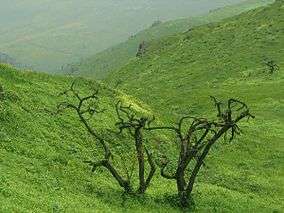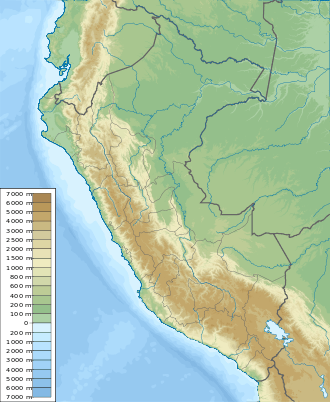Lomas de Lachay National Reserve
| Lomas de Lachay National Reserve | |
|---|---|
|
IUCN category VI (protected area with sustainable use of natural resources) | |
 Lomas de Lachay | |
 | |
| Location |
Lima Region |
| Nearest city | Huacho |
| Coordinates | 11°21′30″S 77°22′10″W / 11.35833°S 77.36944°WCoordinates: 11°21′30″S 77°22′10″W / 11.35833°S 77.36944°W |
| Area | 5,070 ha (19.6 sq mi)[1] |
| Established | June 21, 1977 |
| Visitors | 30,000 visitors/year [1] (in annual estimate) |
| Governing body | SERNANP |
| Website | Reserva Nacional de Lachay (in Spanish) |
The Lomas de Lachay (Lachay Hills) is a national reserve in the desert foothills of Huaura Province in Lima region of Peru. The reserve is located 105 kilometres (65 mi) north from the capital Lima and features a unique mist-fed ecosystem of wild plant and animal species. It expands across an area of 5,070 hectares (12,500 acres). Similar small isolated areas, called Lomas, are found scattered up and down the Peruvian and Chilean coast of the Pacific Ocean. The Lomas de Lachhay is one of the best preserved and protected.
The Lomas de Lachay exist as a result of a combination of coastal climate factors, and subject to a peculiar geography which produces, in an almost rainless desert, heavy clouds, fog and mist called garúa. Garúa rolls in from the nearby Pacific Ocean and the moisture condenses when it reaches spurs of the Andes. The garúa fogs and mist are most common in the humid season, from approximately June to November. The moisture, especially in the humid season, gives life to abundant vegetation and attracts the fauna of the region. Much of the vegetation browns during the dry season.
The National Reserve of Lachay was established in 1977 by means of Supreme Law #310-77-AG to restore and conserve the wild flora and fauna, perform research in order to use the hills rationally and encourage recreation that is ecologically sound.
Flora
Some 150 plant species have been registered inside the park,[1] among them 25 are on their way to extinction. Among the most notable, are the Peruvian papaya, tara, Capparis prisca, Caesalpinia tinctoria and the nettle Loasa urens, which cover the reserve with yellow attractive flowers. There are also numerous grasses, airplants and succulents, like cactus.[1]
Fauna
The common mammals found here are the rodents, but there are other species like the Sechuran fox, the Andes skunk (Conepatus rex), the mountain mouse, and the vizcacha.
Throughout the reserve there are approximately 55 bird species in 15 families, among them are: the burrowing owl, the Andean tinamou, the American kestrel, and diverse species of hummingbirds.[1]
Among the most notorious reptiles are the Peruvian snake (Bothrops pictus) and the curl tail lizard. There are also many arthropods.
Culture
Cultures that have affected the area include the Teatino, Chavín, Tiahuanaco, Mochica, Chimú, Chancay and the Inca.[1]
In the reserve you can find archeological paintings (petroglyphs) and remains from the Pre-Columbian cultures. At the same time, you can appreciate the huge granite and diorite rocks which have worn away over time leaving concavities and soft contours, which are of great geological interest.